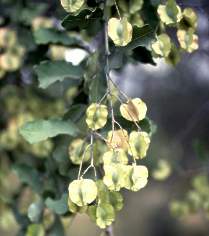Combretum imberbe
Combretum imberbe Wawra
Family: Combretaceae
Common names: leadwood (Eng.); hardekool (Afr.); motswiri (Pedi); ummono (Sotho); mondzo (Tsonga); motswere (Tswana); umbondwe omnyama (Zulu); mohwelere-tshipi (Northern Sotho); muhiri (Venda); omumboromboga (Herero)
SA Tree No: 539
Introduction
Combretum imberbe is the most impressive of our combretums; even when it is dead, leadwood presents an imposing display, with its almost white trunk and gigantic main branches soaring above the surrounding bush.

Description
Description
The magnificent leadwood is a medium to large, semi-deciduous tree, which grows up to 20 m in height. Combretum imberbe is the tallest of all the South African combretums. It has a spreading canopy and is extremely slow growing. The snakeskin-like bark is one of the main features that make identification easier throughout the season. Dead branches and shoots often remain on a matured tree. The colour of the trunk is pale grey to white. The leathery leaves are arranged opposite each other. The flowers are yellowish cream-coloured and have a sweet fragrance. They are produced from November to March. The leadwood produces 4-winged fruit, which are yellowish green and turn pale red when mature from February to June.

Conservation Status
Status
The leadwood is a protected tree in South Africa.
Distribution and habitat
Distribution description
The leadwood can be found in all the bushveld regions and in mixed forest in southern Africa. It is widespread in Lowveld areas and grows along streams and rivers. Combretum imberbe is widespread in northern Namibia. It is also found in Mpumalanga, Limpopo, North-West Province, Mozambique, and into tropical Africa.
Derivation of name and historical aspects
History
The species name, imberbe, is derived from the Latin name referring to the lack of hairs on the plant. Combretum means climbing plant in Latin according to Pliny, and the common name leadwood refers to the heaviness of the wood.
Ecology
Ecology
The leaves are eaten by kudu, impala, red lechwe, grey duiker, elephant, giraffe and the last two eat the branches as well. The presence of leadwood in some areas can indicate to farmers that the grazing is good. Look out for rodents because they enjoy the seeds, while livestock pose a threat to early life stages such as seeds and seedlings.
Uses
Use
Parts of this tree are used by various tribes in a number of ways: smoke that comes from the burning leaves has been used to relieve coughs, colds and chest complaints. The flowers can also be used as a cough mixture. The leaves are believed to have magical powers. For treatment of diarrhoea and stomach pains, root decoctions are used. A combination of roots and leaves are taken against bilharzia. Root bark that is boiled in water is used for tanning leather. The gum that exudes from damaged areas on the stem is edible and forms part of the diet of the Bushmen. Leadwood ash is used as a toothpaste. The wood is very hard and tough, and burns very slowly with intense heat. Africans used this wood to make hoes before metal was discovered. The trunk was used to build an enclosure (kraal ) and grain stamping mortars and these days it is used for furniture and sculptures. The tree has special cultural and religious importance to the Ovambo people of Nambia. The leaves and fruits are used in white magic.
Growing Combretum imberbe
Grow
Seeds that have not been parasitized should be removed carefully from the fruit, so that the seeds are not damaged, it is therefore preferable to select healthy looking fruits, soak them for a few hours and then plant in seedling trays filled with river sand. The seeds should be pressed down and covered with a thin layer of sand, and should be kept moist, not planted too deep and not given too much water. Seedlings will germinate after two weeks. When the seedlings reach the second leaf stage, they should be transplanted into nursery bags. The leadwood is fairly drought resistant, but could be damaged by frost.Combretum imberbe will grow in most well-drained gardens and is quick growing from seeds, under favourable conditions. The leadwood is rarely cultivated but it makes a fine shade tree, though it is big for an average garden.
References
- Carr, J.D. 1988. Combretaceae in South Africa . Conservation Press, Johannesburg .
- Coates Palgrave, K., Coates Palgrave, P. & Coates Palgrave, M. 1985. Everyone's guide to trees of South Africa . Struik, Cape Town.
- Coates Palgrave, M. 2002. Keith Coates Palgrave Trees of southern Africa, edn 3. Struik, Cape Town .
- Esterhuyse, N. 2001. Remarkable trees of southern Africa . Briza Publications, Pretoria .
- Johnson, D. & Johnson, S. 1993. Gardening with indigenous trees and shrubs. Southern Books, Cape Town.
- Palmer, E. & Pitman, N. 1972. Trees of southern Africa . Balkema, Cape Town.
- Thomas, V. & Grant, R. 1998. Sappi tree spotting. Highveld & Drakensburg. Jacana, Johannesburg.
- Van Wyk, B-E. & Gericke, N. 2000. People's plants . A guide to useful plants of southern Africa. Briza Publications, Pretoria.
- Venter, F. & Venter, J. 1996. Making the most of indigenous trees. Briza Publications, Pretoria.
Credits
Patrick Mtsweni
Walter Sisulu National Botanical Garden
April 2006
Plant Attributes:
Plant Type: Tree
SA Distribution: Gauteng, KwaZulu-Natal, Limpopo, Mpumalanga, North West
Soil type: Sandy, Loam
Flowering season: Early Summer, Late Summer
PH: Neutral
Flower colour: Cream, Yellow
Aspect: Full Sun
Gardening skill: Average
Special Features:
Horticultural zones









Rate this article
Article well written and informative
Rate this plant
Is this an interesting plant?
Login to add your Comment
Back to topNot registered yet? Click here to register.